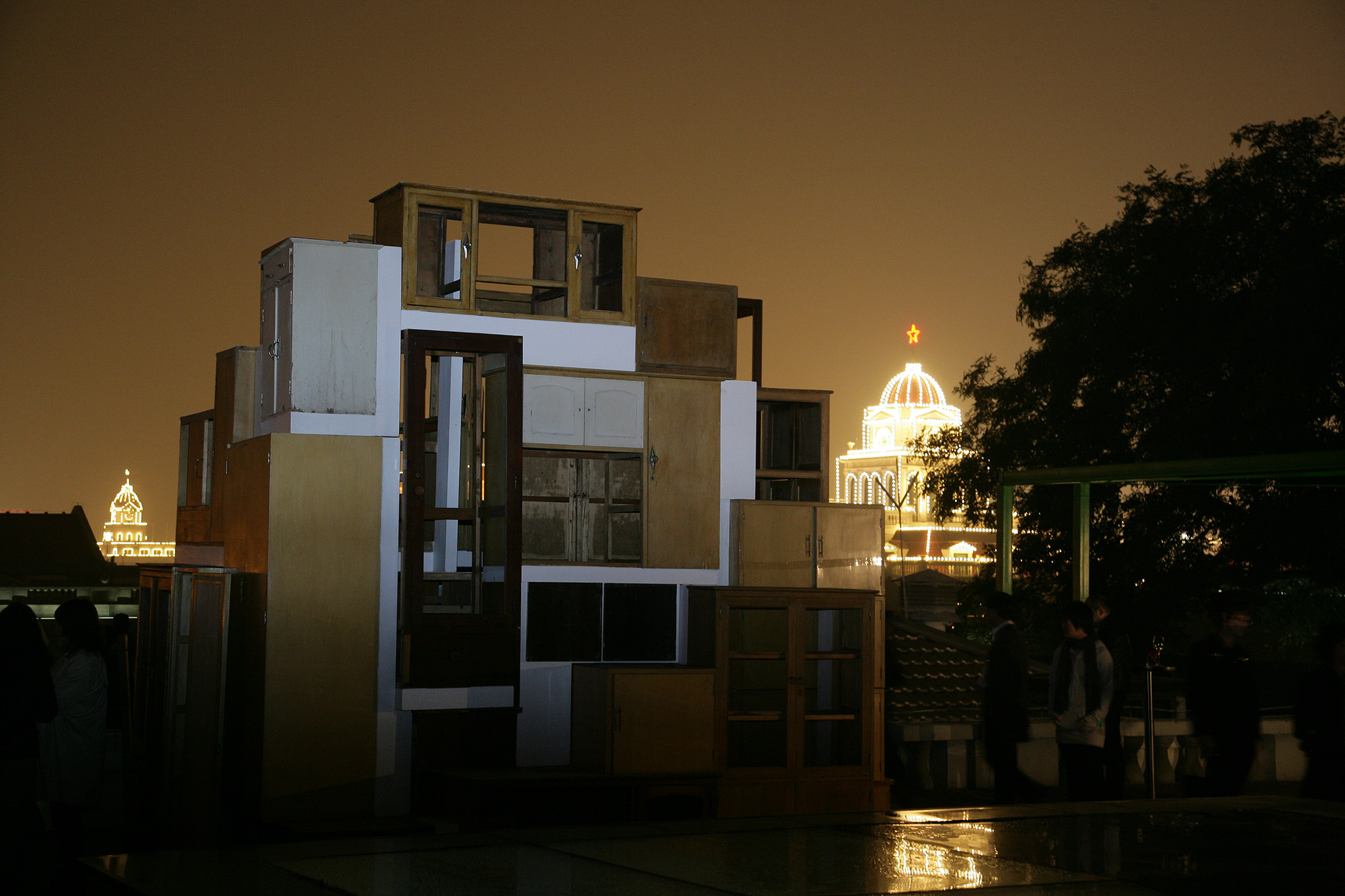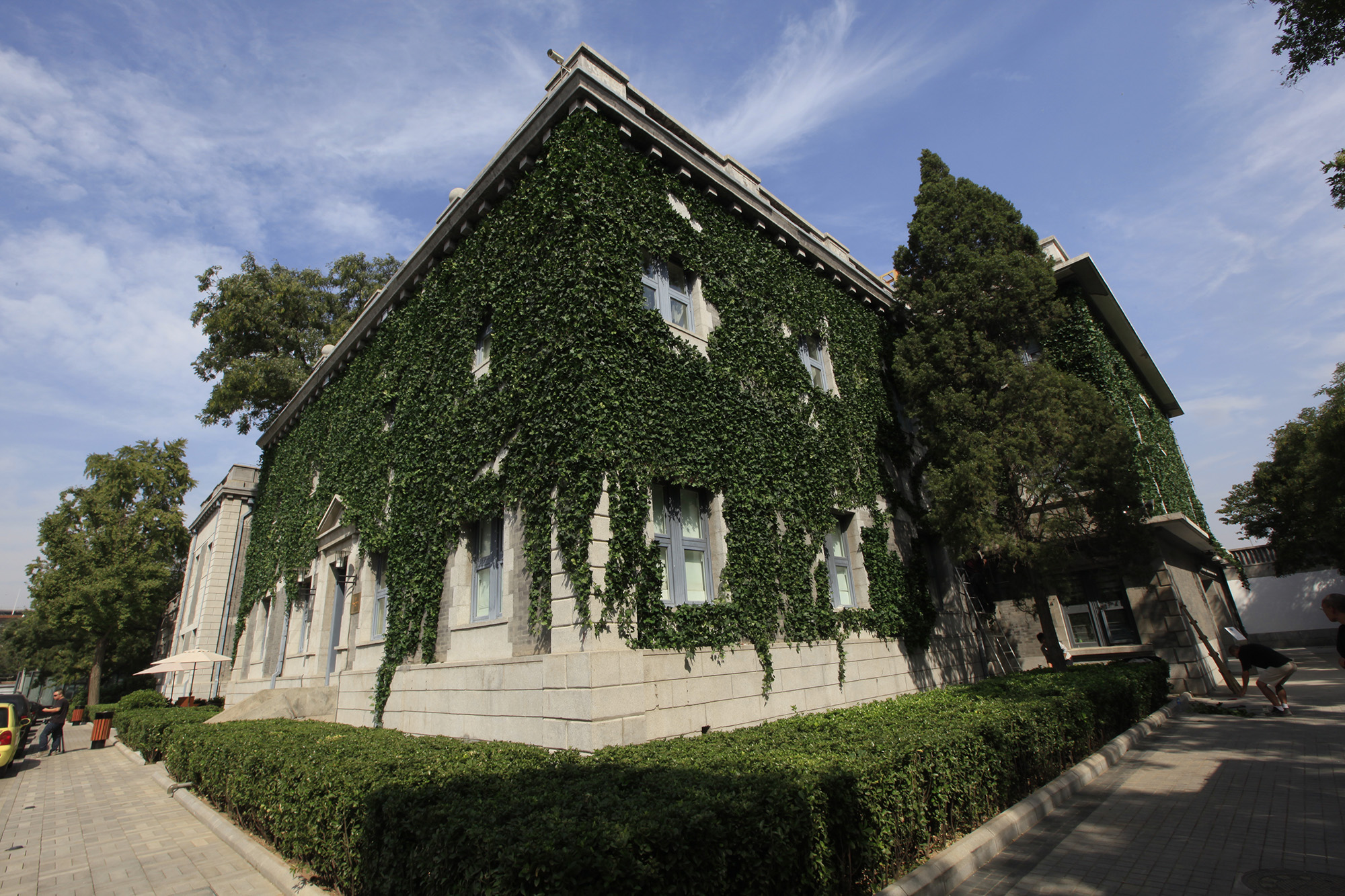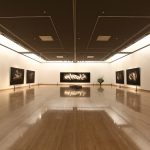Shan Shui: Nature on the Horizon of Art
Venue: Beijing Center for the Arts at Ch’ien Men 23
No.23, Qian Men Dong Da Jie, Dong Cheng District, Beijing
Sponsor: AUDI
Support: Shan Shui Conservation Center
Artistic director: Weng Ling (founder, Beijing Center for the Arts)
Curatorial consultants: Fei Dawei (curator, art critic)
Prof. Lu Zhi (founder, Shan Shui Conservation Center)
Participating artists: Maya Lin, Wang Jianwei, Zhou Wei
Documentary screening: The 11th Hour, Home

Mother Earth is sick
Humanity is sick
In history unseen, we are in danger
Covet all, lose more…
Where to go for us all?
Background
It is obvious that the unprecedented crisis human society faces today triggered the creation of BCA’s annual “Green Art Project”. Human civilization, while satisfying our avarice for material abundance, has at the same time undermined our basis for survival: over-reclamation, deforestation, and urbanization have resulted in a “hot, flat, and crowded” earth with a dysfunctional ecosystem. Meanwhile, we are also suffering from a spiritual: heterogeneity, diversity and tradition have all been assimilated by the tidal wave of the globalization of capital, information, science and technology, and immigration. Like animals confined in concrete jungles, we have never been so anxious and wary as we are today; relationships among ourselves become indifferent, whirling in a vicious circle. Where is nature, the home of lives and spirits?
In 2008, a new round of financial crises worldwide has given us a chance to reflect and think. In the same year, the world’s urban population surpassed for the first time that of rural areas.
Since the 1960’s, the “Green Movement” has gradually taken hold almost everywhere: witness the recognition of “Earth Day” and the great number of environmental groups, the initiative of “Bring your own chopsticks”, the acclaimed LIVE EARTH concert series which has attracted the attention of over two billion people, the frequent stressing of “natural conservation” in government documents, and examinations of “Eco-science & technology” in city planning and construction. Talking about nature conservation has become fashionable, even in politics. It seems that the environmental movement wins many battles, but without realizing that it is losing the war: has nature even been more degraded than it is today? And earth’s condition is worsening with unprecedented speed. Is it the failure of the environmentalists, or all humanity? Is there another way that could more efficiently impose enough impact through a thorough change of our behavior?
Therefore, with the two green projects, BCA is attempting to use art to unfreeze humanity’s frozen senses and repressed love towards nature. We hope that a reflection upon the gains and losses from human development can substantially change the way we living.
Shan Shui – Nature on the Horizon of Art
In the past five years, the team at the Beijing Center for the Arts has extensively interacted with international environmental protection organizations. During a dialogue between Ms. Weng Ling (founding director of the BCA) and Ms. Lu Zhi (founder of the Shan Shui Conservation Center), they discussed similar experiences within contemporary art and biological conservation: both require a magnitude of faith, and the impulse to establish and protect. Both face the challenge of dealing with the public, the market and policies. Their consensus about these parallels became the foundation of the “Shan Shui” project.
“Shan Shui – Nature on the Horizon of Art” is exclusively sponsored by AUDI, and fully supported by the Shan Shui Conservation Center. The serious exhibition, featuring pluralistic viewpoints, and various ways of expression, will present the latest works of several of the world’s top artists and architects: Maya Lin, Wang Jianwei, and Zhou Wei. In addition, the show will include documentary screenings of “The 11th hour”, produced by Leonardo Dicaprio, and “Home”, directed by the renowned French photographer Yann Arthus-Bertrand and co-produced by Luc Besson. The project, comprised of large-scale visual exhibition, documentary screenings, nature conservation plans and a forum, and publications, will not only provide the visitors a full-on sensual experience but also let them think and take part in the discussion about problems facing nature and the ecosystem. We hope that more and more people will devote themselves to the environmental movement. The Nature Conservation Forum will invite a number of prestigious experts and artists, and we hope that the documentations resulting from this interdisciplinary forum will help further the subject’s development.
Based on the principles of facing reality, reflecting essences, practicing scientifically and keeping creative, the exhibition will open up cooperation between China’s contemporary art and its efforts for nature conservation: it is truly an interdisciplinary practice. We sincerely hope to establish a platform for communication with the public – a genuine, open, serious, diverse, and profound platform that will build attention towards and participation in averting ecological disaster.
The nature conservation plan will be carried out by Shan Shui Conservation Center in China’s last wildernesses where giant pandas, Przewalski gazelles (one of the most endangered hoofed animals in the world) and snow leopard remain.
AUDI, the exclusive sponsor of the exhibition, has long focused on the systematic protection of the environment as an integral part of its corporate social responsibility. AUDI is also a strong supporter of many environmental protection activities. Since 1970s, AUDI has led the world in developing environmentally neutral automobiles. The first luxury car brand approved by EMAS (the Eco-Management and Audit System), AUDI will keep environmentally sustainable development its enduring corporate philosophy in terms of product research and development, production and brand culture.
Exhibition Introduction
1.Theme Interpretation
Shan Shui — Nature
Shan Shui, representing “nature”, is widely used in traditional Chinese literature and painting. In the contemporary context, it recalls the natural ecosystem in opposition to urban cities. A simplified explanation of Shan Shui is the “entity of all naturally formed materials and energies; a functioning and structured whole comprising of biotic populations within their living spaces.” The theme focuses on what we see, how we think and how can we make change to protect and respect nature.
Humanity and Nature
The Dialectics say of nature that, “The whole nature lies spread out before us as a system of interconnections and processes.” Tao Te Ching, Chapter 25, says: “The whole universe consists of four elements; one of which is human. Humans should follow the rules of the earth, the earth should follow the rules of heaven, the heaven should follow the rules of Tao, and Tao should follow the rules of nature.” Each life comprises a part of nature. The behavior of humanity has undergone a dramatic change from reverence of nature, to transforming and governing it, dictating and destroying it, and to finally attempting to maintain and conserve it. This relationship is not a simple one-way circle: the same nature that once nurtured us has reacted with riotous revenge. Human and nature are forever contradictory. Exploring this relationship of between humans and nature is the origin of this exhibition.
2.Vision and Mission
– To reproduce the beauty of nature, and explore the Tao within it
– To review the relationship between humanity and nature, and dispel the divisions between natural evolution and human technology
– To demonstrate the love and harmony between humanity and nature
– To investigate the crisis of the earth within the context, spirit and values of science
– To build an idealized version of nature by extensively exploring and expressing diversified interfaces between contemporary art and nature, while integrating scientific experiences with artistic imagination
3.Artists and Artworks Introduction
Maya Lin: “What is Missing?”
Maya Lin is a worldly renowned Chinese-American artist and architect with immense prestige in the international architectural circuit. Her best well-known work is the Vietnam Veterans Memorial, which she designed when she was a 21 year old Yale undergraduate. The 20 years since, Maya Lin’s designs have left her footprints everywhere in US. She was rated as one of the “one hundred most important Americans” and “fifty future American leaders” by Life Magazine, and as one of the hundred most influential Asian-Americans over the last ten years of the 20th century by the A Magazine. In 2005, she was inducted into the National Women’s Hall of Fame.
Lin’s “last memorial” – “What is Missing?” will debut to the world in mid September, 2009; and its Chinese version, incorporating the spatial features of BCA, will be shown during the exhibition of “Shan Shui”. It is a multi-site sound and media installation, committed to commemorate species that are disappearing right before our eyes, questioning the results of our behavior while showing hope. The artist said: “Currently we are experiencing the sixth mass extinction in the planet’s history, and the only one to be caused not by a catastrophic event, but by the actions of a single species—mankind. On average, every 20 minutes a distinct living species of plant or animal disappears at the hands of mankind. At this rate, by some estimates, as much as 30 percent of the world’s animals and plants could be on a path to extinction in 100 years.” Basing on that horrific prospect, Lin has spent many years researching and consulting to accomplish this astonishing work of art. It will create a world of the images and sounds of those species that are disappearing, so that when walking into it, visitors will be able to sensorially feel the ongoing decay of Mother Nature. “What is Missing?” is not only a wakeup call to make people reflect upon their behaviors and be aware of what can be done to help, but also a “greenprint” for a more naturally prosperous future.
Wang Jianwei: “Distance”
Wang Jianwei is one of China’s most influential artists in new media and installation; and the foremost artist in cross-disciplinary experiment and practice. He has a fine grasp of many disciplines, including sociology, philosophy and anthropology. He was the first artist from mainland China who participated “The 10th Kassel Documenta”, and has been invited several times to the world’s major art events, such as the Venice Biennial and the Sao Paulo Biennial, etc. In February 2008, he was awarded the 2008 annual artist grant – the Nobel Prize in the contemporary art world – by the Foundation for Contemporary Art, USA. He is the first Chinese artist to receive the grant.
In this exhibition, by holding a methodological viewpoint, Wang Jianwei will question the phenomenon of how environmental protection has been applied as an ideology or political strategy today. In other words, how can we rationally justify our environmental protection perceptions or the critiques about what we’ve done toward nature in the past? Inspired by “The Monument to the Third International” – a towering symbol of modernism envisioned by Vladimir Tatlin in the 20th century that was intend to dwarf the symbol of capitalism, Eiffel Tower in Paris, but was never built as it was generally considered too expensive and too “capitalistic” by the Communist party , Wang Jianwei will establish an environmental protection monument piercing through the three-story space of BCA by using furniture featuring the so-called “Socialist” style of the 1950’s and ‘60’s. The meaning behind the visual language and the possibility of statement between vision and action, present and future suggested by the work’s origins is to think about the distance between words and actions, form and substance, and ideals and reality.
Zhou Wei: “Natural System”
Zhou Wei is a well-known Chinese architect and artist. Over the past two decades, he has been devoted to theoretic research and practice in the interdisciplinary fields connecting contemporary architecture and art. His installation work of urban city research attracted attention in the Sao Paulo Art Biennial. In 2004 to 2006, he hosted several experimental live art projects that were jointly done by architects and artists, including “Jian · Ge” and “City in Progress – Live Zhangjiang”, which has created a fresh new way of cooperation between contemporary art and public spaces. His conceptual contribution to the design of the China Center to be erected on the remains of Ground Zero will be unveiled in 2013.
The artist discovered that the soaring output of artificial green plants due to increasing demand has already shaped a systematic industry chain for the manufacture of fake plants. It contributes positively to growth in regional GDP and employment. Moreover, with more scientists and designers getting involved in the sector’s research and development, creating better designs recently, fake plants have become more lifelike. By inventing new materials that imitate the principle of green leaves, the industry is able to create “new species”. In his “Natural System”, the artist will focus on the process of “making real”: creating and manufacturing enough of plastic Parthenocissus Himalayana to wrap around the exterior of BCA. It echoes the environmental works of the artist Christo, in response to the Land Art school in the 1960’s and 70’s when environmental movements were emerging all over Europe and North America. The work implies the melancholy contradictory attitude of modern urban life style; and attempts to probe the complicated connections between the concept of environmental protection and economic development.
Turn Mankind’s Darkest Hour to Its Finest!— “The 11th Hour”
Distributed by Warner Brothers in 2007, and produced and narrated by Leonardo DiCaprio, “The 11th Hour”, is undeniably one of the top environmental documentaries of the day. Based on the agreed fact that global warming is an immediate threat, the film went deep into a series of philosophical discussions, such as what roles have humanity played in the deterioration of the earth, in order to raise the awareness of the public. With contributions from over 50 politicians, scientists, and environmental activists, including former Soviet leader Mikhail Gorbachev, physicist Stephen Hawking, Nobel Prize winner Wangari Maathai, and journalist Paul Hawken, the film explained the harm humanity has done to nature and suggested remedies that we can take in our daily life. The visual impact of the film is overwhelming: with astonishing scenes of flood, fire, hurricanes, icebergs cracking, and the shrinking mountains of jungles, it shows that nature is alarming – And that it is time for us to take action.
The Beauty of Earth Depends On You – “Home”
“Home” is a documentary by Yann-Arthus Bertrand, who works both as the photographer and director of the film. Its co-producer is the internationally eminent director, Luc Besson. The film consist of aerial shots of various natural spectacles from over 50 countries: from the Great Barrier Reef in Australia to Kilimanjaro in Kenya, Africa; from the Amazon’s tropical rain forests to Texas’s stretches of cotton fields and China’s industrial city Shanghai. The marvelous landscapes, combined with scores featuring remoteness and sadness, appeal to humanity to save Mother Earth and to live in harmony with nature.
To be expected next:
After “Shan Shui”, BCA will initiate the second “Green Art Project”: “Stereo City: Future China” — International Architecture and Art Invitational Exhibition to search for solutions of building eco-cities for sustainable development.










